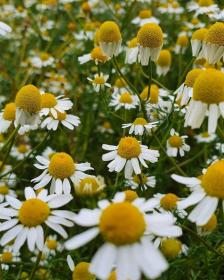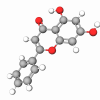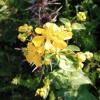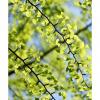Chamomile (also known as Matricaria Recutita, Chamomilla Recutita and, Matricaria Chamomilla) is one of the most popular traditional medicinal plants all over world. Chamomilla Recutita has been used in several skin conditions including slow-healing wounds, inflammation, and infections. It contains a lot of bioactive compounds including several polyphenols and flavonoids (Apigenin, Quercetin, Patuletin, and Luteolin). The known components of the flower extract are the terpenoids bisabolol and oxidized forms azulenes and chamazulene. Matricaria recutita extract has average antioxidant and antimicrobial and significant antiplatelet effects.
Matricaria chamomilla extract contains 1.2% Apigenin that stimulates the synthesis of hyaluronic acid (HA) improving moisture-binding capability, filaggrin and loricrin proteins enhancing barrier function, and natural antimicrobial peptides protecting skin from infections.
Quercetin is a bioactive polyphenol with antioxidant and anti-inflammatory effects. It soothes UV-mediated inflammation and prevents collagen degradation fighting against photoaging.
Chamomile extract is a natural elixir with remarkable benefits that preserves the beauty, youth, and health of the skin.Ingredients
What are the benefits of Matricaria Recutita extract?
The Chamomile extract is suitable for many skincare products and is desirable to help soothe dry skin or help alleviate minor skin irritations. As extracts, they also offer appealing aesthetics and can help enhance the appearance of the formulation itself.
Matricaria Recutita extract is the most researched and documented of all the botanicals and are well known for their anti-inflammatory properties, deriving their efficacy from the collective presence of the plant constituents they contain. Of these substances, those found within the essential oil itself are α-Bisabolol, Chamazulene, Bisaboloxides, and En-in-dicycloether.
Other significant reported substances include the three flavonoids Apigenin, Apigenin -7-glucoside, and Herniarin. Although all contribute, Alpha-Bisabolol and the essential oil are most responsible for the extract's anti-inflammatory action. As the natural isomer, ( -)-α-Bisabolol is more effective as an anti-irritant than its racemate ( ±)-α-Bisabolol and may have a protective action, as it appears to reduce UV -erythema (sunburn).
The extract's efficacy is derived from the whole complex of their chemical constituents, which includes the essential oil, the active components contained therein, and the water-soluble flavonoids. Chamomile extracts' beneficial properties are derived from the natural mix of ingredients and from their tendency to behave synergistically, thereby creating a composite character that gives the extract its anti-inflammatory effect. Matricaria itself is considered a topical counterirritant. It has been established that the presence of antiphlogistic substances contained in Chamomile extracts do, in fact, give them a soothing effect.Flavonoids exhibit similar anti-irritant effects and also have antioxidant characteristics. Often associated with sugars in the form of glycosides, flavonoids are aromatic, heterocyclic, oxygenated compounds found in abundance in higher plant life. They are natural substances that provide most plants and fruits with their color. For example, Apigenin, the main flavonoid found in water-soluble Chamomile extract, is a yellow dyestuff that is known to give hair a blonde tint.




